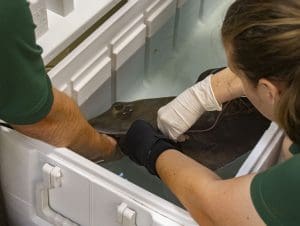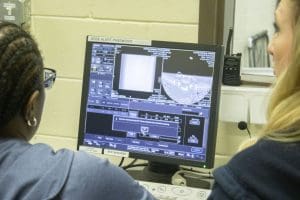

Herps & Aquatics teamed up with our veterinary staff to get Wheeler safely through his scan.
Wheeler, our 3-year-old southern stingray, turned our L3Harris Animal Care Center into a regular Ray’s Anatomy episode when he tried out our new CT machine. This machine recently became fully functional, and it allows our veterinary team to view a 3D reconstruction of x-rays and for better visualization of internal organs.
While various species of turtles and an iguana have tested out the machine prior to Wheeler, the stingray introduced a much bigger challenge than the other Zoo residents: His need to be submerged in a tank of water. This presented a huge risk to the equipment, as a single drop could cause serious issues with the machine. However, after a practice run the day before and some fin-essing the day of, the staff was ready to take on the challenge.

Keepers assisted with all parts of the process, including a blood draw.
Wheeler had not been acting himself for a while prior to the scan. He had been experiencing abnormal breathing, and his keepers noticed that his skin seemed a bit paler than normal. Previous bloodwork showed that he had a high white blood cell count. Various possible diagnoses were on the table, such as leukemia. However, a variety of testing thus far suggests an infection is the cause of the white cell changes. He has been put on antibiotics, but they have failed to make a significant difference for him.
One of our Zoo’s veterinarians, Dr. Kyle Donnelly, along with the rest of the veterinary staff, hoped the scans would clear up the true cause of Wheeler’s sickness. Wheeler was brought into the animal hospital in a large cooler of water outfitted with an air pump. Anesthesia was pumped directly into his water, and he was then transferred into a clear plastic bin filled with water. A little trial and error led to a pair of rolled towels being placed under his wings to prop him up and keep him still enough to go through the scanner. After some maneuvering, and a careful addition of salt water with anesthesia into his container, Wheeler was ready to have his imaging done.

Wheeler’s CT scans were readable despite the obstacle of his water tank.
After the scan was complete, Wheeler was given an ultrasound, additional bloodwork, and had an epigonal organ sample sent to a pathologist. The epigonal organ, which is unique to elasmobranchs (a subclass of cartilaginous fish like rays), is responsible for making blood cells. Since this organ plays an important part of the immune system, this sample may provide more insight into the source of his illness.
We’re waiting to get the results back from these tests. Wheeler recovered from his test and is back in our Indian River Lagoon aquarium for now. The leading theory is that he could be reacting to an infection. He was a great patient to help staff understand how to best help our other aquatic patients that come with the added difficulty of being scanned underwater.
Brevard Zoo is an independent, not-for-profit organization that receives no recurring government funding for our operating costs. Your generous support enables us to continue to serve our community and continue our vital animal wellness, education and conservation programs.
